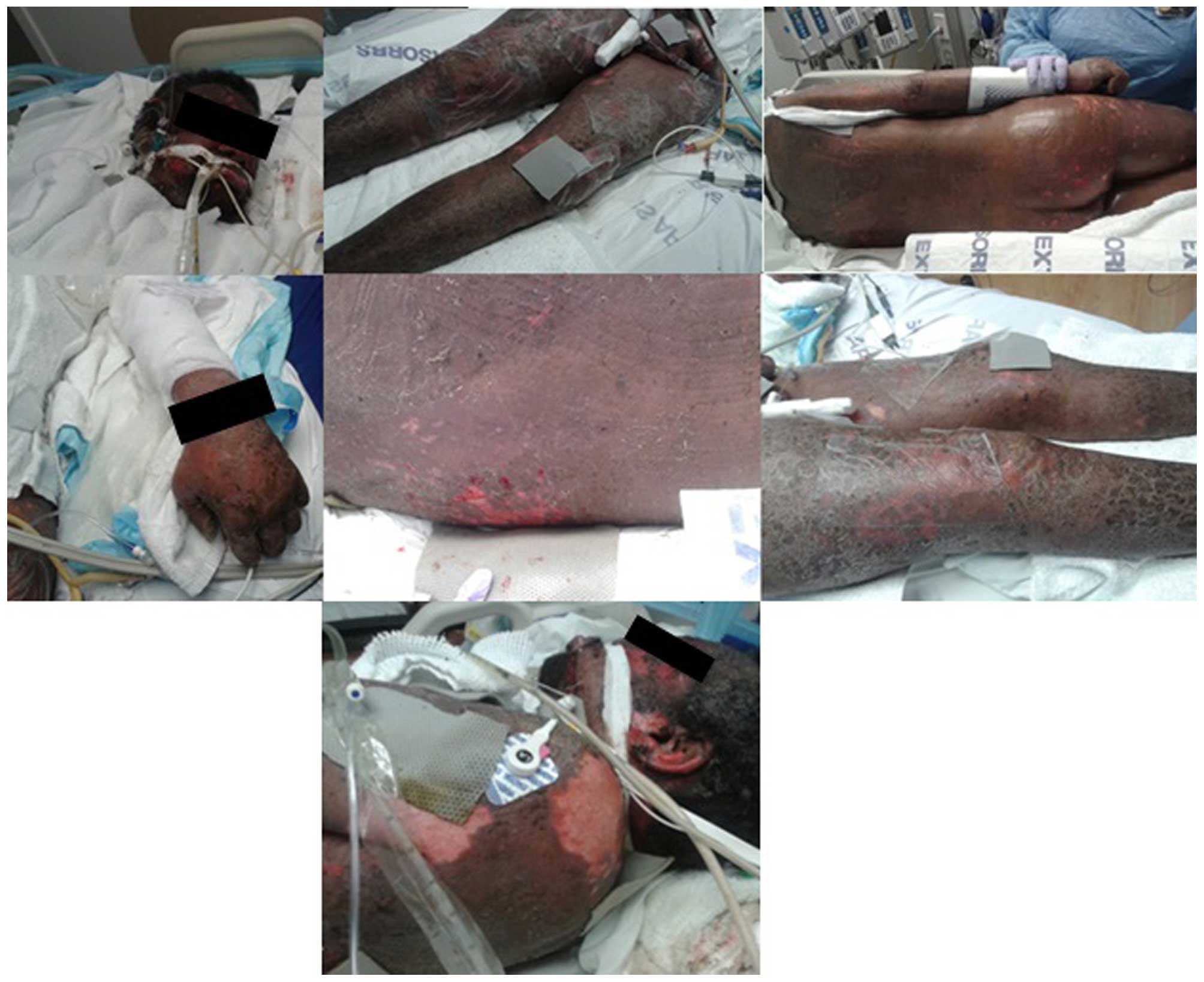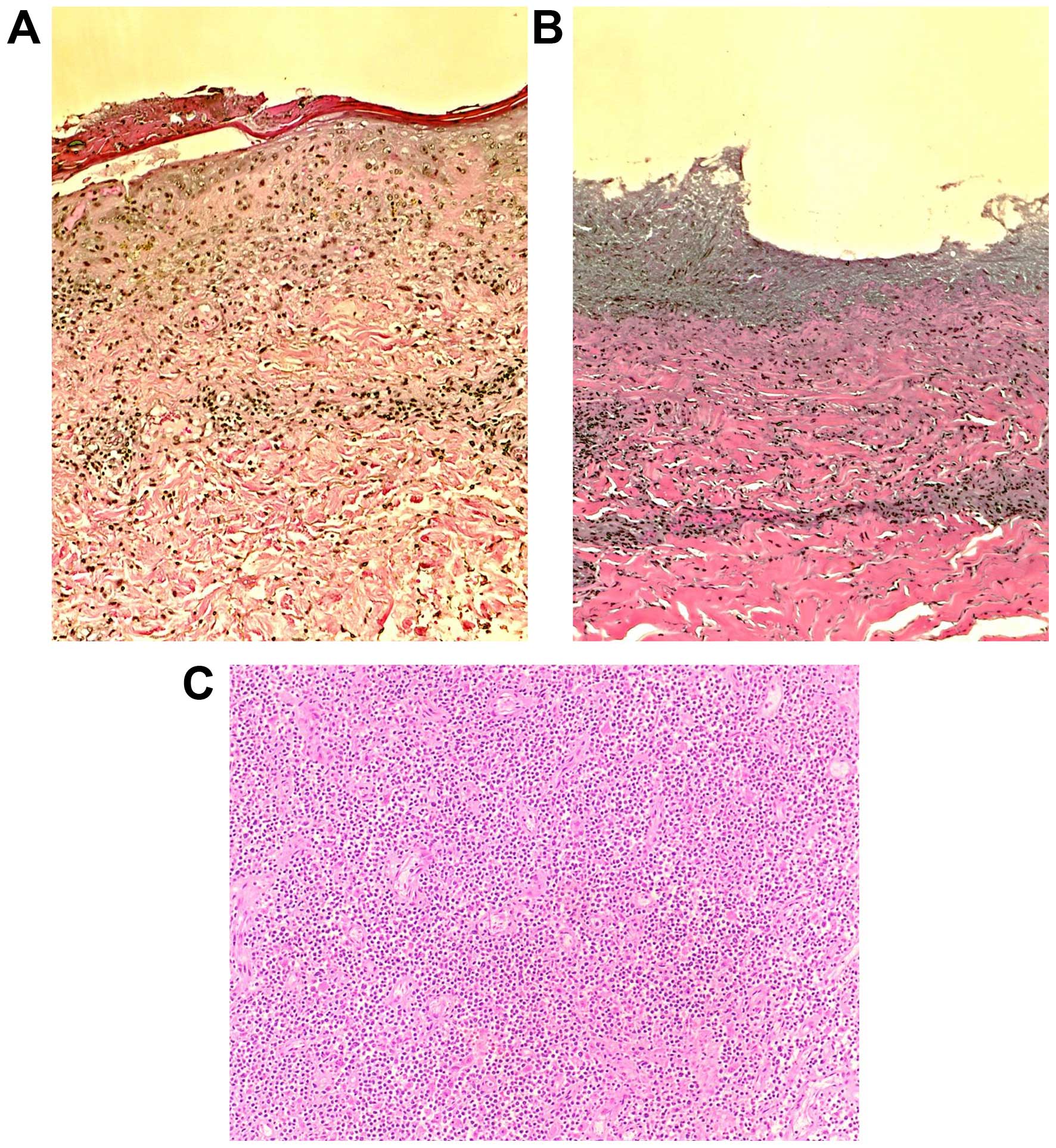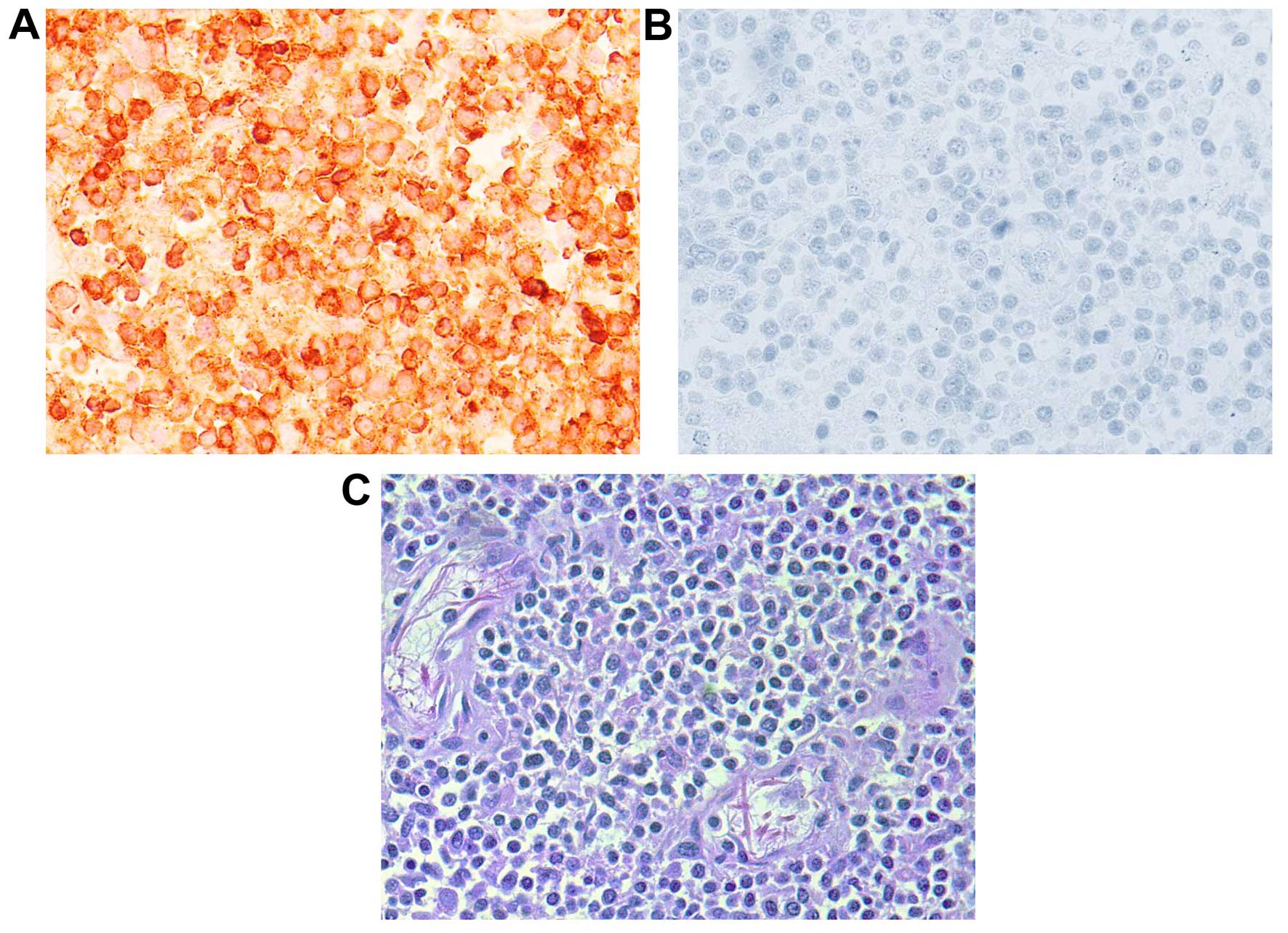Skin rash in the intensive care unit: Stevens‑johnson syndrome, toxic epidermal necrolysis, or a rare manifestation of a hidden cutaneous malignancy: A case report
- Authors:
- Published online on: December 16, 2015 https://doi.org/10.3892/mco.2015.713
- Pages: 413-415
Abstract
Introduction
Toxic epidermal necrolysis (TEN) is a progressive extensive skin disease that is potentially fatal. TEN is defined by formation of bullae and skin sloughing, with purpuric spots covering ≥30% of the body surface area, or skin sloughing and bullae alone, involving 10% of the body surface area. The skin manifestations are associated with a marked systemic inflammatory response syndrome and major electrolyte disturbances, with a mortality rate of >30% (1). TEN is classically medication-induced. A skin biopsy is essential for diagnosis and exclusion of other diseases masquerading as or coexisting with TEN. We herein describe a case where skin biopsy in a patient with classical TEN revealed a cutaneous T-cell lymphoma complicated by TEN. To the best of our knowledge, very few cases of TEN associated with cutaneous T-cell lymphoma have been reported to date (2–4).
Case report
A 54-year-old African-American man with a past medical history of psoriasis diagnosed 6 years prior, diabetes mellitus, chronic pancreatitis, heart failure and hypertension, presented to the emergency department for evaluation of fever (101.7°F for 3 days) accompanied by chills, body aches, pruritus and edema. The patient also reported recent prolonged sun exposure and a progressive scaly rash on his face and neck that had first appeared 3 weeks prior to presentation. The patient attributed his skin rash to methotrexate (MTX) and denied any recent sick contacts, chest pain, weight loss, vomiting, abdominal pain, dysuria, cough or headaches.
The patient's home medications included MTX and prednisone for psoriasis, insulin for diabetes, and lisinopril, metoprolol and aspirin for hypertension and heart failure. All medications were held on admission. In the emergency department, the patient's vitals included an elevated oral temperature of 104.4°F, a heart rate of 168 beats/min, blood pressure 89/70 mmHg and a glucose level of 138 mg/dl. On physical examination, the patient was in moderate distress; his lungs were clear and the cardiac sounds were normal, without any rubs or gallops, but he was tachycardic. The abdomen was soft, with active bowel sounds. The skin examination revealed a dry scaly rash on the upper and lower extremities bilaterally. Erythema and pigmentation were observed on the face, without blisters. Palpable lymph nodes were detected in the bilateral inguinal areas. The laboratory test results revealed leukocytosis (20,900 cells/mm3), but were otherwise unremarkable.
The patient's chest X-ray was normal, but a computed tomography (CT) scan of his chest, abdomen and pelvis revealed bulky axillary lymphadenopathy and prominent mediastinal lymph nodes, with extensive retroperitoneal, external iliac chain and inguinal lymphadenopathy.
The patient was fluid-resuscitated; blood and urine cultures were obtained, and a lumbar puncture was performed prior to starting antibiotics, initially consisting of i.v. vancomycin and cefepime for empiric treatment of sepsis from unknown source. All the cultures were negative and the antibiotics were de-escalated to clindamycin to cover for cellulitis. Despite the negative cultures, the patient developed an altered mental status and underwent a repeat head CT and lumbar puncture, which were normal. At that time, antibiotic therapy was escalated again to i.v. vancomycin, piperacillin/tazobactam and tobramycin for refractory sepsis. The skin was biopsied and a bone marrow biopsy was performed for thrombocytopenia and hemolysis, with an elevated immature platelet count of 8.6%.
Five days later, the patient developed respiratory failure, became tachypneic and tachycardic, with a significantly increased work of breathing, requiring intubation and mechanical ventilation. The skin rash became more desquamative; Stevens-Johson syndrome (SJS) was suspected and was attributed to MTX, which had been held on admission. The clinical picture progressed rapidly to TEN (Fig. 1).
Subsequently, the patient developed acute renal failure requiring hemodialysis. The prior skin biopsy was interpreted as being consistent with T-cell cutaneous lymphoma (Fig. 2). The peripheral blood smear was negative for Sezary cells. Subsequent blood cultures grew vancomycin-resistant enterococcus and candida at 15 days. The antibiotics were changed to fluconazole, daptomycin and meropenem.
The patient's skin rash progressively worsened and, on hospital day 23, it progressed to TEN. Fluconazole was changed to caspofungin, as it is associated with a lower incidence of TEN. Lymph node core needle biopsy was performed, the results of which were consistent with lymphoma (Fig. 3). Given the patient's clinical instability, he was not deemed to be a candidate for chemotherapy. The rash progressively became more extensive and the patient subsequently succumbed to his condition.
Discussion
SJS and TEN have long been viewed as a continuum with escalating severity, as the exfoliating pathology advances to involve larger body areas. Between those rare entities, SJS is 3–5 times more common compared with TEN, and usually encountered in women. Studies have shown that a dysregulated immune response, genetics and drugs may be predisposing risk factors to developing these two pathologies (5).
TEN is an entity frequently seen in the intensive care unit (ICU) and it is usually drug-induced. Thus, this was the initial impression when assessing the present case. Our patient was on MTX for presumed psoriasis. MTX has been found to be associated with TEN. However, the rash progressed from SJS to TEN despite discontinuing MTX. Alternatively, SJS/TEN could have been drug-induced, secondary to the antibiotics the patient received for sepsis. When reviewing the literature, no TEN cases were reported in association with daptomycin, only 4 with pippracillin-tazobactam (6–9), and 12 cases with fluconazole (10–17).
The fact that the patient presented with SJS progressing to TEN despite discontinuing MTX and despite being on antibiotics that have minimal association with TEN, makes the association with cutaneous T-cell lymphoma more likely. Lymphoma was confirmed by skin, bone marrow and lymph node biopsies that solely revealed T-cell lymphoma. There have been several reported cases of TEN in lymphoma patients with presentations similar to our case.
While skin rashes in the ICU are frequently encountered, it is important to perform skin biopsies, particularly when the patient's status progressively deteriorates. It is also important to rule out other causes of desquamating skin rashes, such as human immunodeficiency virus, pemphigoid skin disorders, drug-induced SJS and TEN and, rarely, cutaneous T-cell lymphoma.
A witnessed informed consent for publication of this case report was obtained from the patient's next of kin.
Glossary
Abbreviations
Abbreviations:
|
ICU |
intensive care unit |
|
CT |
computed tomography |
|
MTX |
methotrexate |
|
SJS |
Stevens-Johnson syndrome |
|
TEN |
toxic epidermal necrolysis |
References
|
Pereira FA, Mudgil AV and Rosmarin DM: Toxic epidermal necrolysis. J Am Acad Dermatol. 56:181–200. 2007. View Article : Google Scholar : PubMed/NCBI | |
|
Schoeffler A, Levy E, Weinborn M, Cuny JF, Schmutz JL, Barbaud A, Cribier B and Bursztejn AC: Stevens-Johnson syndrome and Hodgkin's disease, A fortuitous association or paraneoplastic syndrome? Ann Dermatol Venereol. 141:134–140. 2014.(In French). View Article : Google Scholar : PubMed/NCBI | |
|
Jones B, Vun Y, Sabah M and Egan CA: Toxic epidermal necrolysis secondary to angioimmunoblastic T-cell lymphoma. Australas J Dermatol. 46:187–191. 2005. View Article : Google Scholar : PubMed/NCBI | |
|
Sadi AM, Toda T, Kiyuna M, Tamamoto T, Ohshiro K and Shinzato R: An autopsy case of malignant lymphoma with Lyell's syndrome. J Dermatol. 22:594–599. 1995. View Article : Google Scholar : PubMed/NCBI | |
|
Ellender RP, Peters CW, Albritton HL, Garcia AJ and Kaye AD: Clinical considerations for epidermal necrolysis. Ochsner J. 14:413–417. 2014.PubMed/NCBI | |
|
Bajaj P, Prematta MJ and Ghaffari G: A sixty-five-year-old man with rash, fever, and generalized weakness. Allergy Asthma Proc. 32:e1–e3. 2011. View Article : Google Scholar : PubMed/NCBI | |
|
Lam AI, Randhawa I and Klaustermeyer W: Cephalosporin induced toxic epidermal necrolysis and subsequent penicillin drug exanthem. Allergol Int. 57:281–284. 2008. View Article : Google Scholar : PubMed/NCBI | |
|
Craycraft ME, Arunakul VL and Humeniuk JM: Probable vancomycin-associated toxic epidermal necrolysis. Pharmacotherapy. 25:308–312. 2005. View Article : Google Scholar : PubMed/NCBI | |
|
Cheriyan S, Rosa RM and Patterson R: Stevens-Johnson syndrome presenting as intravenous line sepsis. Allergy Proc. 16:85–87. 1995. View Article : Google Scholar : PubMed/NCBI | |
|
Gussenhoven MJ, Haak A, Peereboom-Wynia JD and van 't Wout JW: Stevens-Johnson syndrome after fluconazole. Lancet. 338:1201991. View Article : Google Scholar : PubMed/NCBI | |
|
Islam S, Singer M and Kulhanjian JA: Toxic epidermal necrolysis in a neonate receiving fluconazole. J Perinatol. 34:792–794. 2014. View Article : Google Scholar : PubMed/NCBI | |
|
George J, Sharma A, Dixit R, Chhabra N and Sharma S: Toxic epidermal necrolysis caused by fluconazole in a patient with human immunodeficiency virus infection. J Pharmacol Pharmacother. 3:276–278. 2012. View Article : Google Scholar : PubMed/NCBI | |
|
Pasmatzi E, Monastirli A, Georgiou S, Sgouros G and Tsambaos D: Short-term and low-dose oral fluconazole treatment can cause Stevens-Johnson syndrome in HIV-negative patients. J Drugs Dermatol. 10:13602011.PubMed/NCBI | |
|
Thiyanaratnam J, Cohen PR and Powell S: Fluconazole-associated Stevens-Johnson syndrome. J Drugs Dermatol. 9:1272–1275. 2010.PubMed/NCBI | |
|
Monastirli A, Pasmatzi E, Vryzaki E, Georgiou S and Tsambaos D: Fluconazole-induced Stevens-Johnson syndrome in a HIV-negative patient. Acta Derm Venereol. 88:521–522. 2008. View Article : Google Scholar : PubMed/NCBI | |
|
Ofoma UR and Chapnick EK: Fluconazole induced toxic epidermal necrolysis: A case report. Cases J. 2:90712009. View Article : Google Scholar : PubMed/NCBI | |
|
Craythorne E and Creamer D: Stevens-Johnson syndrome due to prophylactic fluconazole in two patients with liver failure. Clin Exp Dermatol. 34:e389–e390. 2009. View Article : Google Scholar : PubMed/NCBI | |
|
Azón-Masoliver A and Vilaplana J: Fluconazole-induced toxic epidermal necrolysis in a patient with human immunodeficiency virus infection. Dermatology. 187:268–269. 1993. View Article : Google Scholar : PubMed/NCBI |












